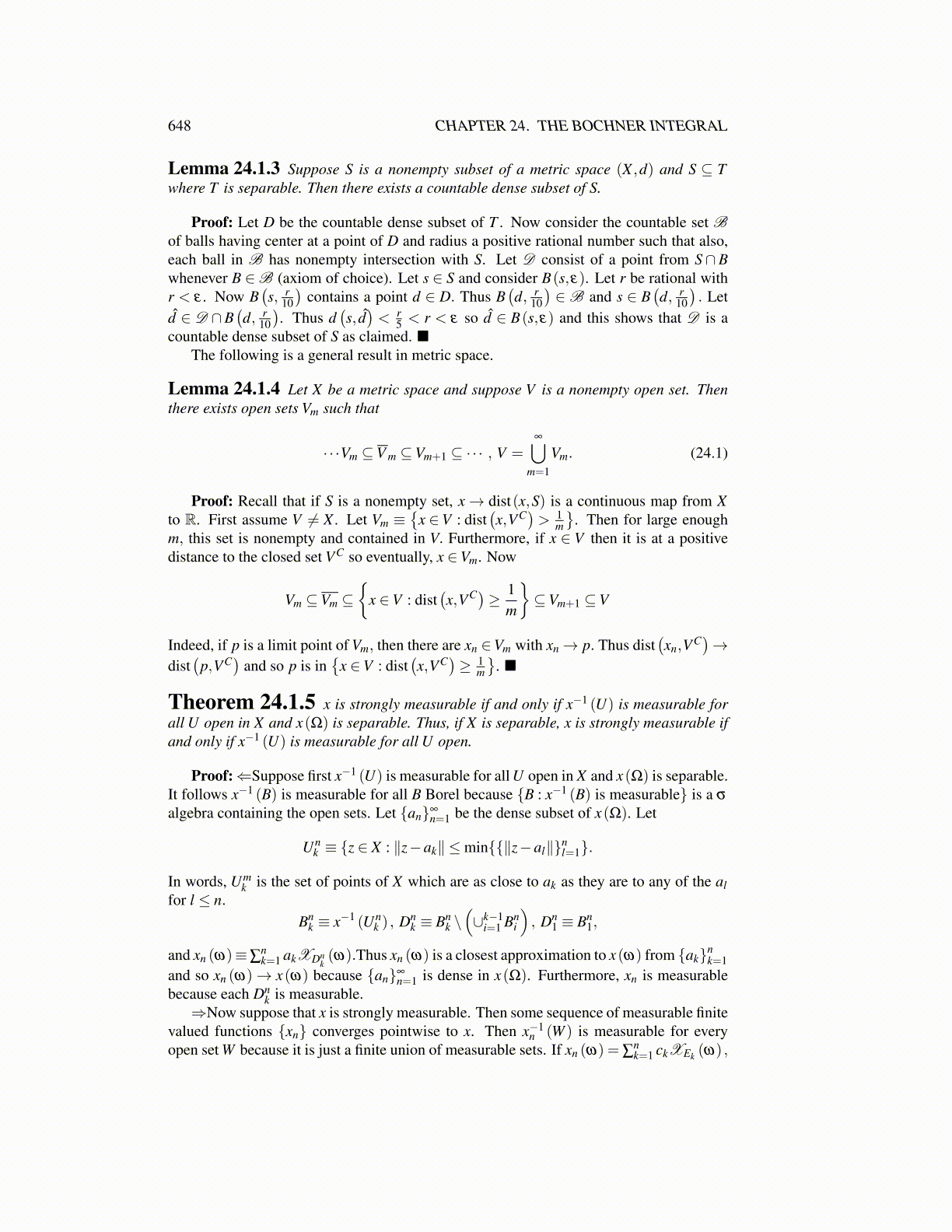
648 CHAPTER 24. THE BOCHNER INTEGRAL
Lemma 24.1.3 Suppose S is a nonempty subset of a metric space (X ,d) and S ⊆ Twhere T is separable. Then there exists a countable dense subset of S.
Proof: Let D be the countable dense subset of T . Now consider the countable set Bof balls having center at a point of D and radius a positive rational number such that also,each ball in B has nonempty intersection with S. Let D consist of a point from S∩Bwhenever B ∈B (axiom of choice). Let s ∈ S and consider B(s,ε). Let r be rational withr < ε . Now B
(s, r
10
)contains a point d ∈ D. Thus B
(d, r
10
)∈B and s ∈ B
(d, r
10
). Let
d̂ ∈ D ∩B(d, r
10
). Thus d
(s, d̂)< r
5 < r < ε so d̂ ∈ B(s,ε) and this shows that D is acountable dense subset of S as claimed. ■
The following is a general result in metric space.
Lemma 24.1.4 Let X be a metric space and suppose V is a nonempty open set. Thenthere exists open sets Vm such that
· · ·Vm ⊆V m ⊆Vm+1 ⊆ ·· · , V =∞⋃
m=1
Vm. (24.1)
Proof: Recall that if S is a nonempty set, x→ dist(x,S) is a continuous map from Xto R. First assume V ̸= X . Let Vm ≡
{x ∈V : dist
(x,VC
)> 1
m
}. Then for large enough
m, this set is nonempty and contained in V. Furthermore, if x ∈ V then it is at a positivedistance to the closed set VC so eventually, x ∈Vm. Now
Vm ⊆Vm ⊆{
x ∈V : dist(x,VC)≥ 1
m
}⊆Vm+1 ⊆V
Indeed, if p is a limit point of Vm, then there are xn ∈Vm with xn→ p. Thus dist(xn,VC
)→
dist(
p,VC)
and so p is in{
x ∈V : dist(x,VC
)≥ 1
m
}. ■
Theorem 24.1.5 x is strongly measurable if and only if x−1 (U) is measurable forall U open in X and x(Ω) is separable. Thus, if X is separable, x is strongly measurable ifand only if x−1 (U) is measurable for all U open.
Proof:⇐Suppose first x−1 (U) is measurable for all U open in X and x(Ω) is separable.It follows x−1 (B) is measurable for all B Borel because {B : x−1 (B) is measurable} is a σ
algebra containing the open sets. Let {an}∞n=1 be the dense subset of x(Ω). Let
Unk ≡ {z ∈ X : ∥z−ak∥ ≤min{{∥z−al∥}n
l=1}.
In words, Umk is the set of points of X which are as close to ak as they are to any of the al
for l ≤ n.Bn
k ≡ x−1 (Unk ) , Dn
k ≡ Bnk \(∪k−1
i=1 Bni
), Dn
1 ≡ Bn1,
and xn (ω)≡∑nk=1 akXDn
k(ω).Thus xn (ω) is a closest approximation to x(ω) from {ak}n
k=1and so xn (ω)→ x(ω) because {an}∞
n=1 is dense in x(Ω). Furthermore, xn is measurablebecause each Dn
k is measurable.⇒Now suppose that x is strongly measurable. Then some sequence of measurable finite
valued functions {xn} converges pointwise to x. Then x−1n (W ) is measurable for every
open set W because it is just a finite union of measurable sets. If xn (ω) = ∑nk=1 ckXEk (ω) ,